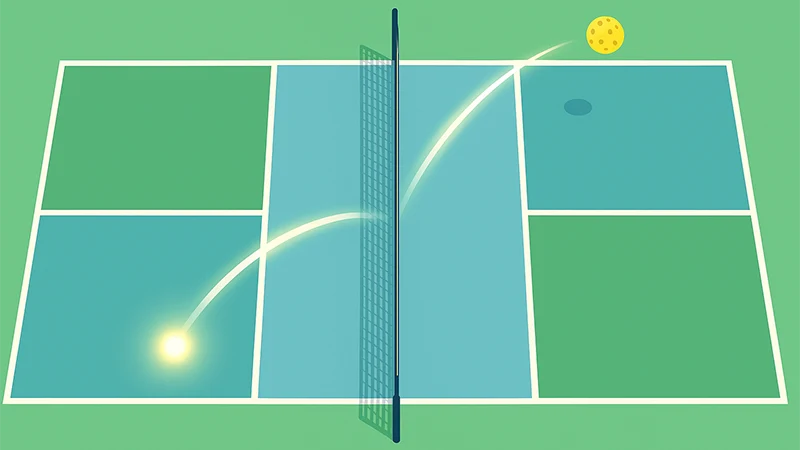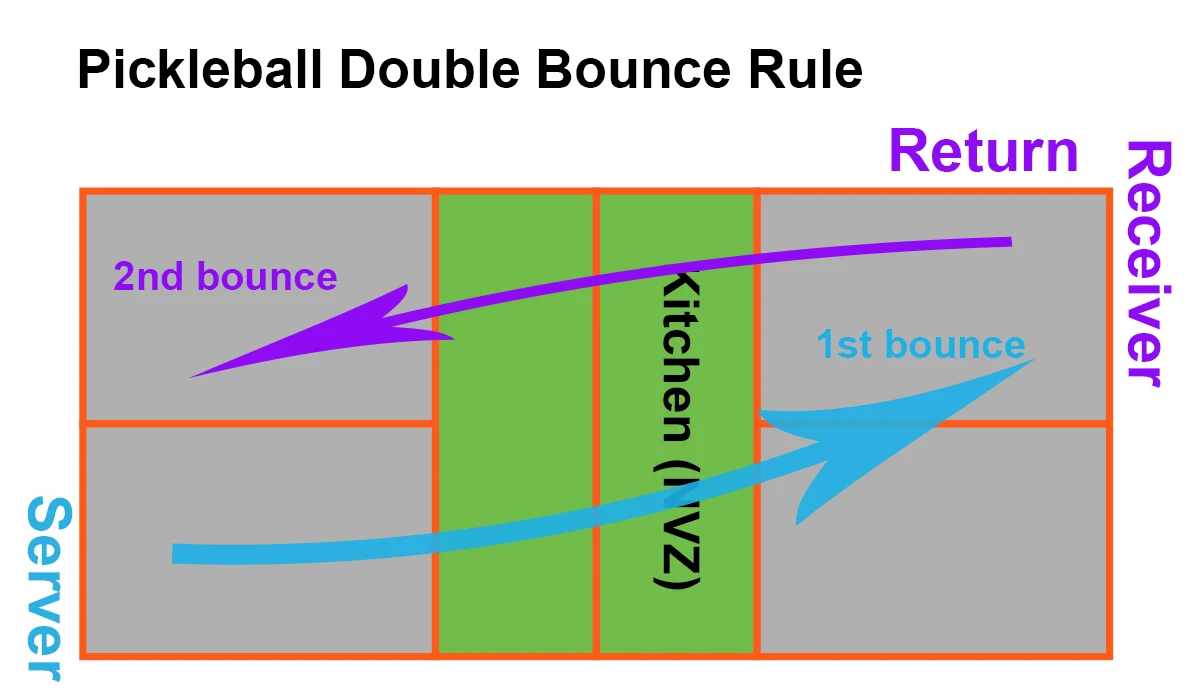The Ultimate Guide to Pickleball Double Bounce Rule

CEO & Technical Expert at Pickleball Equipment Company (Art Pickleball)
Specialize in manufacturing pickleball paddles, pickleball balls, and pickleball accessories.

The pickleball double bounce rule is one of the first rules you’ll hear about on court, and also one of the easiest to mix up.
Players talk about the “double bounce rule”, the two-bounce rule, and “double-bounce faults”, and suddenly nobody is sure when you’re allowed to volley or how many times the ball can bounce on each side.
This guide keeps it simple.
You’ll learn exactly what the pickleball double bounce rule means, how the official two-bounce rule works after the serve, what counts as a double-bounce fault, and when you’re allowed to start volleying so you can stop arguing about the rule and start using it with confidence.
What Is the Double Bounce Rule in Pickleball

The double bounce rule in pickleball (officially the two-bounce rule) says that, at the start of every rally, the ball must bounce once on each side before anyone is allowed to volley.
- On the serve, the ball must bounce once on the receiver’s side before they hit it.
- On the return of serve, the ball must bounce once on the server’s side before they hit it.
- After those two bounces, both teams are free to volley (hit the ball out of the air) or keep playing groundstrokes.
- If a player volleys the serve or the return before it bounces, they break the double bounce rule. This is a fault and the rally ends.
Official reference: See the USA Pickleball Official Rulebook (2025) – “Two-Bounce Rule” under Unique Features and Fault Rule 7.A in Section 7.
Is the Two-Bounce Rule the Same as the Double Bounce Rule?
Players often use these phrases like they’re the same, but the rulebook does not.
How Players Use the Terms
On most courts you’ll hear things like:
- “Don’t forget the double bounce rule after the serve.”
- “We’ve had our two bounces, you can volley now.”
In everyday pickleball talk, “double bounce rule” usually means the same thing as the two-bounce rule you just learned: the serve must bounce once on the receiver’s side, the return must bounce once on the server’s side, and only then can anyone volley.
That’s the meaning this article uses when we say “double bounce rule in pickleball.”
What the Official Rulebook Says
The two-bounce rule (listed under “Unique Features” and enforced by Rule 7.A) says:
- The serve and the service return must each bounce before the ball is struck.
- A double bounce is defined in Rule 3.A.8 as when the ball bounces twice on one side before it is returned.
Together with Rule 7.E, this is a fault and the rally is over.
So:
- The two-bounce rule / “double bounce rule” (casual term) talks about the first two shots after the serve.
- A double bounce (fault) talks about the ball **bouncing twice on the same side at any time during the rally.
When players say “Remember the double bounce rule”, they almost always mean the two-bounce rule at the start of the rally, not the double-bounce fault.
What Is the Two-Bounce Rule of Pickleball
The two-bounce rule of pickleball is the official name for what most players casually call the double bounce rule.
It controls the first three shots of every rally: the serve, the return of serve, and the third shot.
Here’s how it works step by step:
1. Serve:
- The serving team hits the ball diagonally into the correct service box.
- The ball must bounce once on the receiver’s side before anyone on that team can hit it.
2. Return of serve:
- The receiving team plays the return.
- The ball must now bounce once on the server’s side before anyone on the serving team can hit it.
3. Third shot and beyond:
- After those two required bounces, both teams are free to volley (hit the ball out of the air) or keep playing groundstrokes off the bounce.
The two-bounce rule is the same in singles and doubles.
Its whole purpose is to stop the serving team from rushing the net and ending points immediately, and to give both sides at least one groundstroke before the volley game begins.
What Is a Double Bounce in Pickleball
A double bounce in pickleball is when the ball bounces twice on the same side of the court before it is returned.
When that happens, the ball is dead and the rally is over – it’s a fault.
This is different from the double bounce rule / two-bounce rule you learned earlier:
- The two-bounce rule talks about the first two shots after the serve – one bounce on the receiver’s side, one bounce on the server’s side, then you can volley.
- A double bounce talks about any time during the rally when a player lets the ball bounce twice on their side before hitting it. In that case, they lose the rally.
In games you’ll often hear people say “That was a double bounce” when someone reacts too late and the ball dies on their side of the court.
How Many Times Can the Ball Bounce on Your Side in Pickleball
During normal play, the ball is allowed to bounce once on your side before you hit it.
If it bounces twice before you swing, that’s a double bounce and you lose the point.
The only time you’ll hear people talk about “two bounces” in a good way is at the start of the rally, when the double bounce rule / two-bounce rule has been satisfied:
- First bounce on the receiver’s side (after the serve).
- Second bounce on the server’s side (after the return).
After that, every extra bounce on your side before you hit the ball is simply too late – and it’s a fault.
Why Does the Double Bounce Rule Exist in Pickleball
The double bounce rule exists to keep pickleball fair and playable for everyone, not just big hitters who rush the net.
In sports like tennis, the serving team has a huge advantage because they can attack the net right away.
Pickleball was designed differently.
By forcing one bounce on the receiver’s side and one bounce on the server’s side before anyone can volley, the rule levels the playing field:
- The serving team can’t just sprint forward and smash the ball immediately.
- The receiving team is guaranteed at least one chance to hit a solid groundstroke.
- Both sides have time to move their feet, get into position, and start a real rally.
The double bounce rule also shapes strategy.
Those first two bounces create space for the famous third shot — usually a drop or a drive — which is one of the key skills in pickleball.
Instead of every point ending in one or two swings, the rule encourages longer rallies, softer touch shots, and more thoughtful tactics, especially for beginners and mixed-ability groups.
Without the double bounce rule, most points would be serve, charge, smash, done.
With it, pickleball stays closer, more tactical, and a lot more fun to teach and play.
How Can You Use the Double Bounce Rule to Your Advantage
The double bounce rule isn’t just a restriction.
If you understand it well, it actually gives you a built-in game plan for the first three shots of every rally.
Strategy for the Serving Team
Serve deep and to the backhand.
- A deep serve pushes the receiver back, so their first bounce is already close to the baseline. That makes it harder for them to attack their return.
Don’t sprint all the way to the net after serving.
- You’re not allowed to volley the return anyway. Take a couple of controlled steps forward, watch the ball bounce on your side, then move through the third shot.
Use the third shot to move forward.
- After the two required bounces, your third shot decides the rally.
- A soft third-shot drop gives you time to reach the non-volley zone line.
- A hard third-shot drive works when the receivers are off balance or standing too close to the baseline.
Strategy for the Receiving Team
Stand a step or two behind the baseline.
- This gives the serve room to bounce and keeps you from crowding the ball on the first bounce.
Aim for a deep, high-percentage return.
- Your goal is to make the second bounce (on the server’s side) land near or behind their baseline. That makes their third shot much tougher and often forces a defensive lob or high ball.
Use the bounce time to win the kitchen line.
- While the ball is traveling back toward the serving team and bouncing on their side, you should already be moving toward the non-volley zone line.
- If you and your partner get there first, you own the strongest position on the court.
Common Tactical Mistakes With the Double Bounce Rule
Volleys on instinct.
- New players often forget and volley the serve or the return in mid-air.
- It feels aggressive, but it’s an automatic fault.
Watching the ball instead of moving.
- Players stand and admire their serve or return, then get caught stuck in the middle of the court when the third shot comes back.
Giving away free third shots.
- Short serves or short returns put the second bounce near the middle of the court, right in the opponent’s strike zone.
- Deep, high-margin shots are almost always better.
If you’re running pickleball for a school, club, or community program, having consistent paddles and balls makes a huge difference when you teach the double bounce rule. When the bounce is predictable, beginners pick up the rule — and the third shot — much faster.
We manufacture wholesale & custom pickleball paddles and pickleball balls in bulk for programmes that need durable, rule-compliant equipment.
Can You Volley the Return of Serve in Pickleball
No, you can’t volley the return of serve in pickleball.
Because of the double bounce rule, both the serve and the return of serve must bounce once before anyone is allowed to hit the ball out of the air.
Think of the start of every rally like this:
- The serve lands in the correct service box and bounces once on the receiver’s side.
- The receiver hits the return.
- The ball must now bounce once on the server’s side before anyone on that team can hit it.
- Only after these two bounces can either team start volleying.
If a player volleys the serve or the return in mid-air, they break the double bounce rule.
That’s a fault, and the rally is over.
Can You Volley the Serve in Pickleball
No.
The serve has to bounce in the receiver’s court before it can be played.
If the receiver or their partner hits the serve out of the air, it’s an immediate fault and the serving team wins the point.
Does the Double Bounce Rule Apply in Both Singles and Doubles
Yes.
The double bounce rule is exactly the same in singles and doubles:
- Serve → must bounce once on the receiver’s side.
- Return → must bounce once on the server’s side.
- After that, volleys are allowed (as long as players respect the kitchen rule).
The only difference is court coverage: in singles you simply have more ground to cover between those two bounces.
Can the Second Bounce Land in the Kitchen
Yes.
For the purposes of the double bounce rule, the second bounce can land in the non-volley zone (kitchen) and it still counts, as long as the ball is in.
Players just need to remember:
- The ball can bounce in the kitchen any time.
- You just can’t volley while standing in the kitchen or touching the kitchen line.
So if the return drops into the kitchen on the server’s side, the serving team must let it bounce, then step behind the line before volleying the next ball.
What If the Ball Clips the Net Before It Bounces
If the serve or the return of serve clips the top of the net, crosses over, and then lands in the correct court, the double bounce rule still works the same:
- The ball must bounce once on that side before it’s hit.
If the ball hits the net and doesn’t cross over (it drops back on the hitter’s side), the ball is dead and the rally ends—there’s no double bounce rule to apply because the shot never became a legal ball in play.
Final Thoughts
In short, the pickleball double bounce rule is just this: at the start of every rally, the serve must bounce once on the receiver’s side, the return must bounce once on the server’s side, and only then can anyone start volleying—after that, if the ball ever bounces twice on your side before you hit it, it’s a fault and the rally is over.
Recommended Reading
Pickleball Rules: The Complete Guide (2025 Update) – all the core rules in one place, from scoring to faults and the kitchen.
